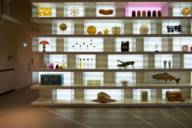
The Deutsches Museum is one of the oldest and largest science and technology museums in the world. What makes it so special? Its unique approach to education: Here, you can find countless hands-on experiments – science you can touch. We highlight seven particularly exciting ones.
In most museums, the rule is: “Don’t touch!” At the Deutsches Museum it's the opposite. In the approximately twenty permanent exhibitions, visitors are encouraged to touch, experiment, solve puzzles and tinker. This sparks creativity – after all, the achievements displayed in the exhibitions are all build on such inventive spirit.
- Suturing wounds in the Medical Exhibition
- Experimenting in the Chemistry Exhibition
- Milking a cow in the Agricultural Exhibition
- Taking Off in the Flight Simulator
- Conducting in the Music Exhibition
- Launching a Rocket in the Space Exhibition
- Writing Secret Messages in the Image, Writing and Codes Exhibition
Curiosity or disgust – or a mix of both – are the typical reactions when the topic of surgery comes up. Which group you belong to (and whether you should per-haps reconsider pursuing a medical career) can be discovered in the Medical Exhibition. Here, you can try your hand at being a surgeon and practice suturing a wound. For those in the disgusted group, the good news is the injury is made of plastic. Using two forceps, called needle holders, you guide the thread through the fake skin and tie it off, following the instructions. With this “double knot,“ doctors close wounds without touching them with their fingers. The exhibition also highlights the evolution of medical technology and medication over the centuries. The scalpel, for example, has remained unchanged for hundreds of years.
If the sight of lab coats and test tubes brings back memories of stressful chemistry classes, don't worry – there are no detentions or grades here. At the Chemistry Exhibition, you can focus on the best part of school: experimenting. Simply pick up one of three experiment sets at the counter and try your hand at being a chemist. How about testing the conductivity of water? With a measuring device, distilled water, salt water and mineral water, you can find out which type of water conducts electricity best.
“Everything is science“ – that's the motto of the Deutsches Museum. The exhibits go beyond physics and chemistry to explore everyday life. On the third floor, you'll even find a piece of nature: a cow. Well, it's a plastic cow with a rubber udder and instead of milk, water flows from its teats, but you can still try your hand at milking it. If you're interested in farming and animal husbandry, a glimpse behind the barn doors also offers insights into their impact on the environment and health.
Unless you're a pilot, the chance to sit in an airplane cockpit is rare. At the Deutsches Museum's flight simulator, however, you can get pretty close. During the “Flight Simulator“ demonstration, you'll soar over mountain ridges, navigate through dangerously dense fog and learn fascinating facts about modern aviation. You cannot control the aircraft yourself, since the simulator is a professional training device. But if you manage to grab a seat in the centre of the presentation room, the immersive 180-degree screen will quickly make you forget that you are still on solid ground.
Please note: The flight simulator is part of the daily changing programme. Check the Deutsches Museum website to find out whether it will be demonstrated during your planned visit.
It's 1845 and you're tasked with conducting Wagner's opera “Tannhäuser and the Singers' Contest at Wartburg.“ But where are the violinists and trombonists? They're not in their seats – yet. In the Music Exhibition, you can take up the virtual conductor's baton and arrange the different instrument groups using a tablet. This interactive experience offers a fun way to learn how an orchestra works. If you get everything right, you'll be rewarded with harmonies through your head-phones – and with the tap of a finger, you can adjust the strings and wind instruments.
The Space Exploration Exhibition is particularly popular – perhaps because many children once dreamed of becoming astronauts. And for some, that dream became reality. Their achievements, along with many other fascinating exhibits, are on display here. If you want to rekindle your childhood dream, you can launch a miniature rocket. It operates on the same physical principles as a real rocket. With the slight difference that it does not burn fuel, but takes off with the help of compressed air – and is a lot smaller.
In the Codes Exhibition, you can test your skills on the infamous Enigma cipher machine – the encryption device used by the German army to secure their radio communications.
In the Codes Exhibition, you can test your skills on the infamous Enigma cipher machine – the encryption de-vice used by the German army to secure their radio communications.
World War II was not only fought on battlefields, but also in secret rooms, where cryptographers worked to decode enemy messages. In the Codes Exhibition, you can test your skills on the infamous Enigma cipher machine – the encryption device used by the German army to secure their radio communications. With each key press, the exhibit, which is a simplified version of the Enigma machine, sends electricity through a different path creating a unique secret alphabet. If you're up for a brain challenge, this is the place to be.